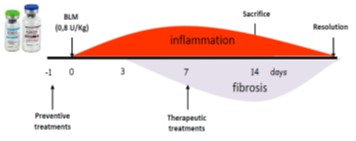
In BSRC Fleming, pulmonary fibrosis is induced in C57BL6/J mice, 8-12-weeks-old, by oropharyngeal administration of BLM (3, 4), as approved appropriately. Mice are sacrificed 7/14/21-days post BLM administration, roughly corresponding to the (post-acute) inflammatory, fibrosis and resolution phases of disease development respectively. Surviving mice that received BLM lose weight, accompanied by a gradual increase in pulmonary oedema and inflammation. Col1a1 mRNA expression, a hallmark of pro-fibrotic gene expression, is also gradually increased post BLM, as also reflected at the soluble collagen levels in the BALF. Accordingly, histopathological analysis of the lungs of mice post BLM administration indicates the increasing presence of peribronchiolar and parenchymal fibrotic regions. As a result of the deterioration of lung architecture, respiratory functions are significantly impaired, as determined with flexiVent, including significant increases in Resistance (R), tissue elasticity (H) and significant reductions in static lung compliance (Cst), respiratory system compliance (Crs) and total lung capacity (A).
References
1. Tashiro J, Rubio GA, Limper AH, Williams K, Elliot SJ, Ninou I, et al. Exploring Animal Models That Resemble Idiopathic Pulmonary Fibrosis. Frontiers in medicine. 2017;4:118.
2. Mouratis MA, Aidinis V. Modeling pulmonary fibrosis with bleomycin. Curr Opin Pulm Med. 2011;17(5):355-61.
3. Barbayianni I, Ninou I, Tzouvelekis A, Aidinis V. Bleomycin Revisited: A Direct Comparison of the Intratracheal Micro-Spraying and the Oropharyngeal Aspiration Routes of Bleomycin Administration in Mice. Frontiers in medicine. 2018;5:269.
4. Zannikou M, Barbayianni I, Fanidis D, Grigorakaki T, Vlachopoulou E, Konstantopoulos D, et al. MAP3K8 Regulates Cox-2-Mediated Prostaglandin E(2) Production in the Lung and Suppresses Pulmonary Inflammation and Fibrosis. J Immunol. 2021;206(3):607-20.